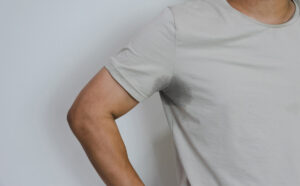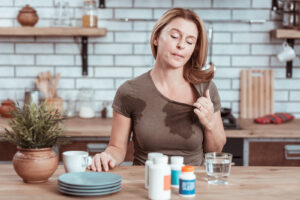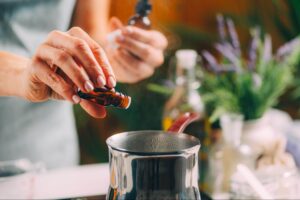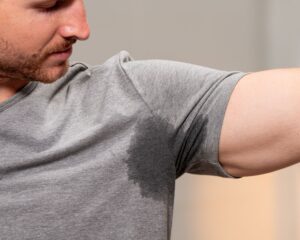If you’re one of the roughly 8 million Americans who deal with excessive sweating (also known as hyperhidrosis), this article is for you. (1)
Psst…while we’re chatting about hyperhidrosis: check out these doctor-recommended products for excessive sweating!
As you browse this list of the best hyperhidrosis treatment solutions, you’ll learn about…
- How each hyperhidrosis treatment works
- Health risks
- Treatment Costs
- Benefits & Effectiveness
- Insurance coverage
Traditional hyperhidrosis treatments, like antiperspirants and iontophoresis, are a great place to start.
Modern treatments like Botox and miraDry have brought relief to thousands of people suffering from excessive sweating and hyperhidrosis.
If you feel like you’ve tried everything to treat excessive sweating, don’t lose hope!
At least one of these treatments is bound to make a difference.
This article is not a substitute for medical advice and we recommend consulting with your doctor before starting any treatment for excessive sweating.
Hyperhidrosis Symptoms
Hyperhidrosis can turn your body, and your self-confidence, into a puddle of goo.
Some patients only get excessive underarm sweating or excessive sweating in a few areas, like the hands and feet.
However, most people with hyperhidrosis have excessive sweating in several areas all at once—including the underarms, face, head, and more.
When diagnosing new patients, doctors look for the following symptoms of hyperhidrosis:
- Excessive sweating that started before the age of 25
- At least one episode of excessive sweating a week for at least 6 months
- Equal sweating occurs on both sides of the body
- Your sweat gets in the way of daily activities
- You stop sweating while you’re sleeping
- Family history of sweat problems (2)
Did you answer “yes” to two or more of the above questions?
It may be time to talk with your doctor about the possibility of hyperhidrosis and potential treatments for excessive sweating.
Is There a Cure for Hyperhidrosis?
Officially, there’s no known cure for hyperhidrosis, but many of the treatments in this guide have effectiveness ratings of 80% or more.
In fact, sometimes all it takes is an over-the-counter antiperspirant to bring symptoms down to a manageable level.
Sweat not, fearless moisture warrior!
There is hope, and it might be just a treatment away.
11 Hyperhidrosis Treatments for your consideration:
1. Over-the-Counter Clinical-Strength Antiperspirants
Before you dive into prescription antiperspirants or other hyperhidrosis treatments, try an over-the-counter clinical-strength antiperspirant.
Aluminum-based over-the-counter (OTC) antiperspirants work by plugging and contracting sweat pores. (3)
As a result, sweat doesn’t build up on the skin surface and cause visible sweat marks and spots.
“Aluminum salts are the main topical agents for hyperhidrosis. Their mechanism of action is attributed to either an interaction between aluminum chloride and keratin in the sweat ducts (duct closure) or to a direct action on the excretory eccrine gland epithelium.” (4)
Note: Clinical-strength antiperspirants work best when applied before bedtime and left to set overnight.
Improvement in symptoms may be noticed as early as 1 week. Once improvement is achieved, applications can occur every other day to weekly as needed to control symptoms.
Compared to standard OTC antiperspirants, clinical-strength sweat blockers contain up to 25% more active ingredients.
Let’s take a closer look at two of the most popular clinical-strength antiperspirant products to stop armpit sweating available.
SweatBlock Antiperspirant Wipes With DRIBOOST®

What It Is: Pre-Soaked Antiperspirant Wipe (Towelette)
Active Ingredient: 14% Aluminum Chloride—Clinical Strength
Treatment Areas: Underarms & Body
How It Works: Gently dab a SweatBlock antiperspirant wipe to the problem area(s) before bed (works best if applied at nighttime). While you sleep, SweatBlock creates a block over your sweat pores that keeps embarrassing sweat from pooling on the skin or soaking through clothing.
Effectiveness: Based on customer surveys, SweatBlock is effective for up to 7 days per application. Results will vary. Most SweatBlock users can expect 3-6 days of dryness based on their body chemistry and sweat severity.
Cost: $19 for Original SweatBlock Wipes, $25 for XL SweatBlock Body Wipes
SweatBlock also has treatments for face, hand, and foot sweating.
Certain Dri Clinical-Strength Roll-On
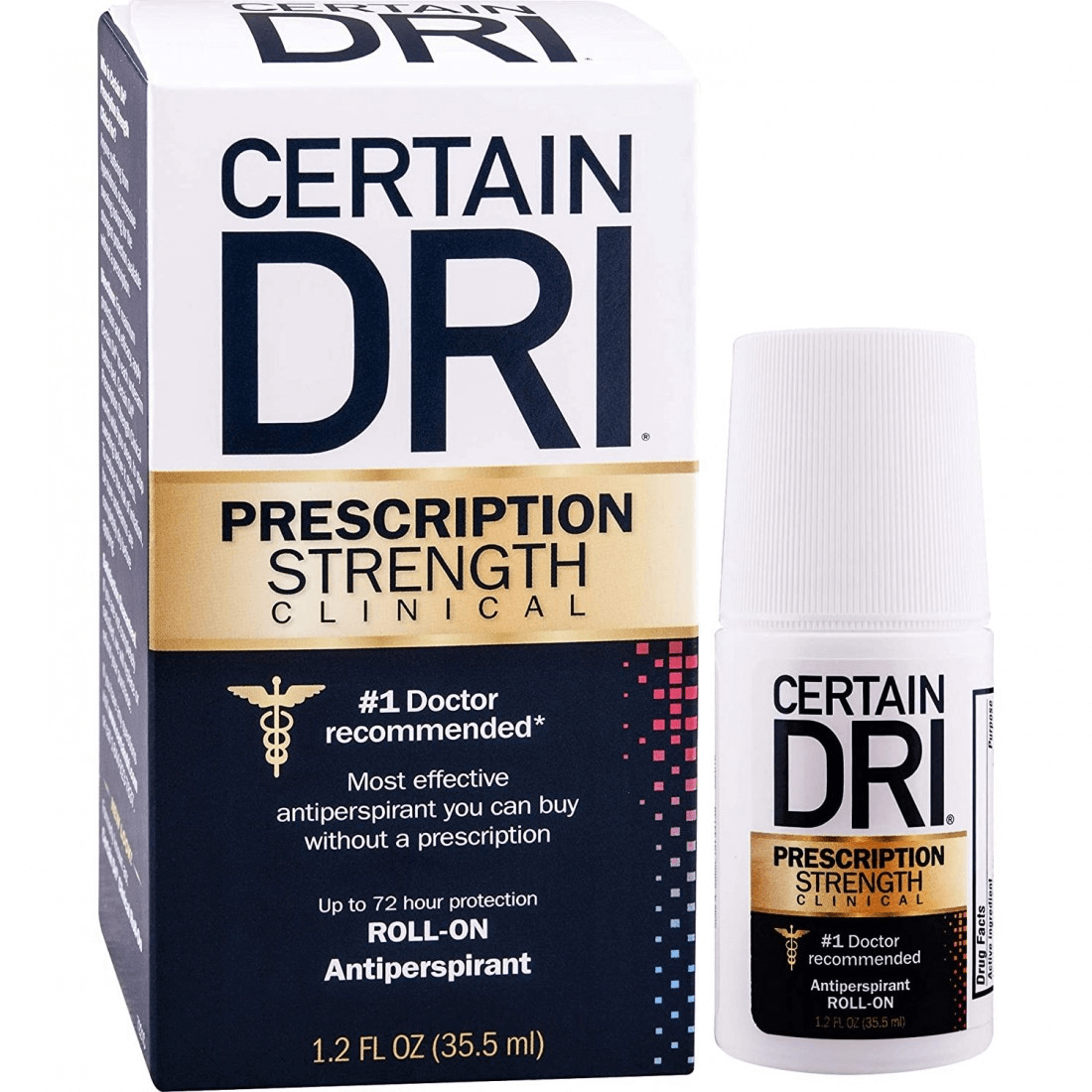
What It Is: Antiperspirant Roll-On (also available in lesser-strength stick)
Active Ingredient: 12% Aluminum Chloride—Clinical Strength
Areas Treated: Underarms
How It Works: Apply to underarms before bed. Certain Dri plugs and blocks pores, preventing excess sweat on the skin’s surface.
Effectiveness: Up to 72 hours
Cost: $5.67 per bottle
Regardless of which brand you choose, dermatologists recommend trying a clinical-strength antiperspirant before moving on to other options.
But what if OTC antiperspirants don’t stop the sweat?
It may be time to talk to your doctor about a stronger sweat treatment.
2. Prescription Antiperspirants
Unlike OTC antiperspirants, which are less likely to cause skin irritation, prescription antiperspirants go all in on the sweat-blocking…even if the result is unwanted side effects.
Instead of using regular aluminum chloride, prescription antiperspirants (for underarms) often contain 6.25%-20% aluminum chloride hexahydrate.
However, formulations for sweaty hands and feet can be as high as 30%.
Other brands are made with formaldehyde instead of aluminum.
Some of the most common prescription antiperspirants are:
- Drysol (20% aluminum chloride hexahydrate)
- Xerac AC (6.25% aluminum chloride hexahydrate)
- Formalaz (10% formaldehyde)
For many patients, aluminum chloride hexahydrate is the most effective, but it also tends to cause skin irritation if you don’t follow the instructions closely.
Avoiding skin irritation is the key to using prescription antiperspirants.
Never apply them to the underarms within 24 hours of shaving in order to reduce the risk of inflammation. Also avoid applying during episodes of heavy sweating. Some patients go the extra mile and will dry their armpits with hair dryers prior to application.
If prescription antiperspirants leave you burning, but the sweat keeps flowing, there’s still hope!
3. Qbrexza (Anticholinergic Wipes)
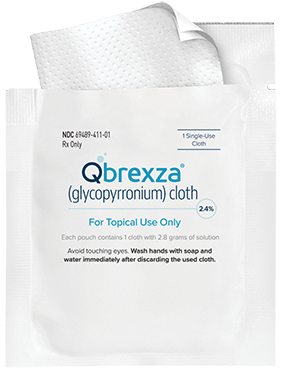
Your dermatologist may ultimately recommend a new prescription wipe called Qbrexza, which is a treatment designed specifically for people with severe hyperhidrosis.
Apply these products just once a day to stop armpit sweating (one wipe is enough for both arms).
Instead of aluminum, Qbrexza contains 2.4% glycopyrronium, an anticholinergic compound that inhibits the chemicals that trigger sweating.
But once again, the extra sweat-stopping power comes with a few uncomfortable side effects, including:
- Urinary retention
- Muscle cramps
- Dry mouth
- Burning/stinging
According to a 2019 review published in the American Journal of Clinical Dermatology, studies show that Qbrexza can reduce sweating severity by as much as 30% after four weeks of treatment. (5)
At the same time, researchers found that the side effects were mild-to-moderate and that treatments were “generally well tolerated.”
Alternatively, there are oral hyperhidrosis treatments your doctor may recommend.
4. Oral Anticholinergics
Just like Qbrexza, oral anticholinergics stop sweating by inhibiting the chemicals that trigger sweating—but instead of applying it topically, you take it as a pill.
Common anticholinergics include:
- Oxybutynin
- Glycopyrrolate
According to a 2019 report, anticholinergic medications come with a list of significant side effects, including:
- Dry eyes
- Dry mouth
- Constipation
- Blurred vision
- Urinary retention
- Heart rhythm disturbance
- Cognitive problems (confusion)
- Dizziness due to drop in blood pressure upon standing (postural hypotension) (6)
The elderly are even more at risk.
For example, a 2015 study published in JAMA Internal Medicine found a potential link between anticholinergic use and dementia. (7)
Due to these side effects, oral anticholinergics are not recommended as a long-term solution.
With that said, they can still be part of a healthy short-term solution for special events like weddings.
Either that, or just plan to get married in the rain so you’ll blend right in!
Curious about more oral medications for profuse sweating?
You still have another option.
5. Beta Blockers and Benzodiazepines
Beta blockers (clomipramine, bupropion) and benzodiazepines (Xanax) may be prescribed for very specific cases of hyperhidrosis linked to psychological triggers.
By blocking the neurotransmitter activity that leads to event-driven sweating (like anxiety attacks) episodes of severe sweating can be avoided, especially when it comes to the hands and feet.
However, both types of medications (but especially benzos) can become habit-forming and may have long-term negative effects on the liver.
Instead of taking Xanax, your dermatologist might recommend that you inject your treatments instead…
6. Botox Injections (Botulinum Toxin)
Yep, the same stuff that can reduce wrinkles can also block sweat.
Research shows that Botox can be a safe and effective way to reduce sweating in the face, head, armpits, hands, and feet.
Botox, or onabotulinumtoxinA, is a purified protein that can be injected into the skin to temporarily block the secretion of chemicals that cause sweat.
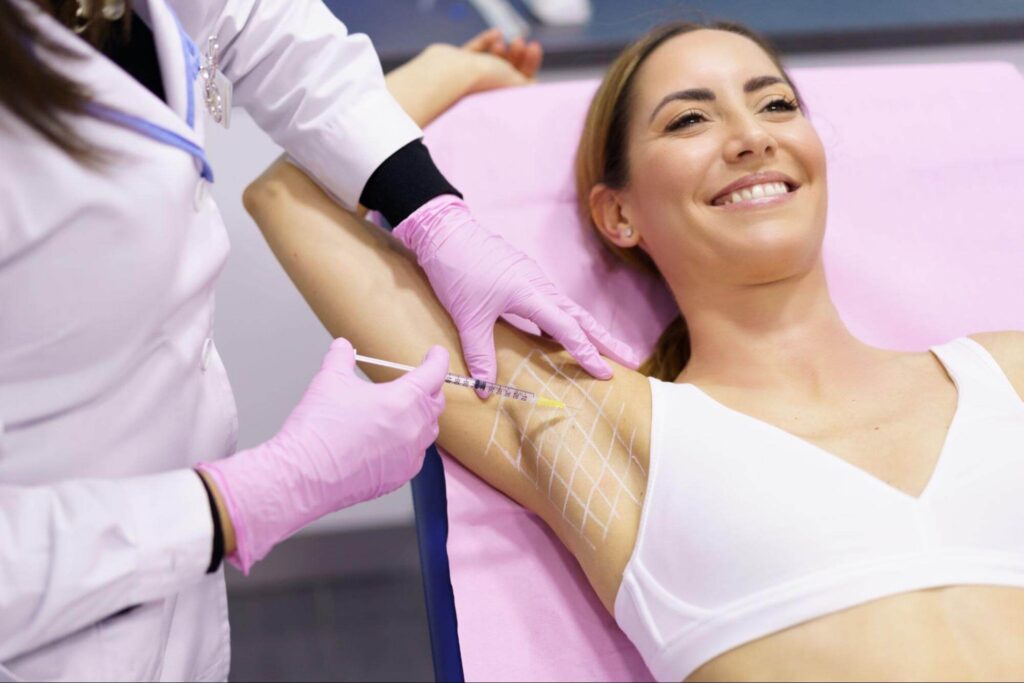
Injections are made just below the surface of the skin, and although the needles are small, local anesthesia is typically used to numb the area.
After all, those armpits can be sensitive!
Botox has been shown to decrease sweating by up to 82-87% within 2 to 4 days of the initial hyperhidrosis treatment.
The effects generally last 3 to 6 months, but can last up to 16 months in rare cases. (8) The duration of efficacy may increase with subsequent injections. (16)
On average, additional Botox injections are needed every 6 months and are 80-90% effective for palmer (hand) sweating.
When Botox is injected into the hands to treat palmar sweating, it can cause temporary pain and weakness in the hands.
If you’re not into needles or pain, you may be more interested in the next treatment for hyperhidrosis.
7. Iontophoresis
Iontophoresis is an old school treatment for hyperhidrosis that keeps getting more effective thanks to advancements in technology.
In a nutshell, iontophoresis works by passing a mild electric current through a shallow container of water.
For mild to moderate hyperhidrosis, plain tap water is typically used.
However, a cholinergic inhibitor like glycopyrrolate or glycopyrronium bromide may be added for severe hyperhidrosis cases.
The patient’s hands or feet are then immersed in the solution for 15-45 minutes.
Some devices come equipped with pads that can be attached to the underarms and other areas.
According to the American Society of Dermatological Surgery, iontophoresis is considered a first-line treatment along with clinical-strength antiperspirants. (9)
However, the majority of dermatologists recommend trying antiperspirants first.
Studies show that iontophoresis can reduce palmoplantar sweating by up to 81%. (10)
The best part is that there aren’t any significant side effects to worry about, and all it takes is just one session a week to maintain results.
In most cases, you can self-administer treatments at home with your own device, which run between $350 and $1,000.
8. Microwave Therapy (miraDry)
MiraDry can be used as a treatment for axillary hyperhidrosis and excessive underarm sweating but isn’t approved for other areas like the hands and feet.
It works by zapping the sweat glands with an electromagnetic current, rendering them useless.
A 2013 study published in the Journal of Cosmetic and Laser Therapy was one of the first to prove that miraDry can reduce problematic sweat. (11)
In the study, 11 patients received a single miraDry treatment and were followed up with seven months later.
According to the Hyperhidrosis Disease Severity Scale (HDSS), 93.8% of participants showed a good-to-excellent decrease in foul-smelling sweat, while 83.3% experienced a significant decrease in underarm sweat.
Here’s how dermatologist Carolyn Jacob, MD, described the results:
“The treatment of primary axillary hyperhidrosis can be rewarding using noninvasive microwave technology. Because the microwaves preferentially target the region of skin where the sweat glands reside, leading to localized thermolysis of the sweat glands, patients can now benefit from permanent targeted sweat reduction. The microwave treatment has been shown to be safe and effective in 6000+ procedures to date.” (12)
On average, sweating is reduced by 82% after two treatments (separated by 3 months), although a third treatment is sometimes necessary.
Side effects are usually limited to mild redness, altered skin sensation, swelling, and discomfort and can be easily treated with over-the-counter anti-inflammatories like ibuprofen (Advil) and acetaminophen (Tylenol).
Total costs hover around $3,000 depending on where you live.
As if microwaves and electrotherapy weren’t futuristic enough, you can always zap your sweat glands with lasers…
9. Laser Therapy
Lasers can be focused into a very narrow beam, allowing physicians to target the sweat glands without damaging the surrounding tissue.
All that’s required is a few tiny incisions in the skin and the procedure takes less than an hour.
Side effects like mild bruising, numbness, and swelling typically heal within 1 to 2 weeks.
Ultimately, this means that you can recover faster and get back to work sooner.
Although there are currently only two studies involving a total of 33 patients, the early evidence is promising: when researchers followed up with the patients six months after surgery, they found a 78% reduction in sweat severity. (13)
10. Sweat Gland Removal
Underarm sweat gland removal involves either excision (cutting the gland out), curettage (scraping the gland out), or liposuction (sucking the gland out).
With that said, excision is generally no longer used because it can cause heavy scarring and lead to significant problems with range of motion.
There’s also a new technique that combines liposuction with laser therapy to liquefy the tissue containing the sweat glands.
Unfortunately, local surgeries aren’t an option for sweating of the hands, feet, and face due to the high likelihood of complications.
And finally, one of the most intense treatments for hyperhidrosis:
11. Nerve Surgery (Sympathectomy)
Endoscopic thoracic sympathectomy (ETS) is a last resort for palmer (hand) sweating.
During the procedure, the surgeon attempts to block the nerve signals coming from the spinal cord to the sweat glands.
It’s a very invasive procedure that requires full anesthesia and comes with a significant amount of risk.
This hyperhidrosis treatment is usually reserved for candidates that meet the following characteristics:
- Age < 25 years
- BMI < 28
- Absence of sweating during sleep
- Resting heart rate greater than 55 beats per minute
- No significant comorbidities (i.e. heart disease, diabetes, hypertension etc.)
During the operation, a miniature camera is inserted into the chest under the armpit and the lung is temporarily collapsed.
Talk about nerve-racking!
It also comes with a long list of possible side effects, including excessive compensatory sweating, hypotension, heat intolerance, and heart arrhythmia.
Plus, ETS has a mortality rate of 0.045%.
With that said, it isn’t all downsides: a study of the long-term results of ETS found that 65% of patients are ultimately fully satisfied with the procedure. (14)
Insurance typically covers ETS, but what about coverage across different companies, claims, and insurance plans?
Is Treatment for Hyperhidrosis Covered by Insurance?
Most major healthcare providers cover hyperhidrosis treatments.
For example, Blue Shield of California covers several treatments for focal hyperhidrosis as long as you’re medically diagnosed with:
- Acrocyanosis of the hands
- History of recurrent skin maceration with bacterial or fungal infections
- History of recurrent secondary infections
- History of persistent eczematous dermatitis despite medical treatments with topical dermatologic or systemic anticholinergic agents (15)
As long as you meet any of these requirements, you should be eligible for the following treatment options:
- Aluminum chloride solution (20%)
- Botox
- Endoscopic transthoracic sympathectomy (ETS) and surgical excision of axillary sweat glands, if conservative treatment (i.e. aluminum chloride or botulinum toxin, individually and in combination) has failed
Other insurance companies that offer hyperhidrosis coverage include:
- Aetna
- Cigna
- Dean Health System
- Excellus BlueCross BlueShield
- HealthPartners
- Independence Blue Cross
- Keystone
- Medica
- Premera Blue Cross
If your claim is denied or you feel that more of your expenses should have been covered, you can oftentimes make an appeal.
To argue your case, document all of your expenses and download a letter of medical necessity for your doctor to sign.
Keep in mind that insurance policies are always changing and for the most up-to-date information you’ll have to contact its members’ services directly.
Can Hyperhidrosis Be Cured Naturally?
NOTE: these hyperhidrosis treatments are not supported by substantial clinical evidence and potential side effects of supplements are not fully known.
Several home remedies and lifestyle choices may help with sweating, including eating right and reducing stress.
For starters, certain foods like sugar, carbs, peppers, and caffeine can trigger sweating in some individuals.
At the same time, exercise, meditation, and deep breathing can help normalize your stress response and reduce the risk of sweat-inducing stress.
Organic supplements may also be worth a shot, including:
- Passionflower
- Cordyceps
- Ashwagandha
- Valerian root
These plants can help reduce the risk of severe anxiety that may lead to sweating.
Finally, you can also apply natural astringents like apple cider vinegar, sage, or witch hazel directly to the skin to shrink the pores.
This is partly why aluminum chloride antiperspirants can be so effective, although natural remedies provide nowhere near the same results.
Everyone’s experience with hyperhidrosis is different, and most dermatologists recommend starting with a clinical-strength antiperspirant before focusing on other options.
At that point, if you’re still wetter than a monsoon, it may be time to pursue second, third, and fourth-line treatments for hyperhidrosis like prescription antiperspirants and medical procedures.
References:
- Reference 1: https://www.sciencedaily.com/releases/2004/07/040728084348.htm
- Reference 2: https://www.ncbi.nlm.nih.gov/pmc/articles/PMC3705293/
- Reference 3: https://www.ncbi.nlm.nih.gov/pmc/articles/PMC4218921/
- Reference 4: https://www.ncbi.nlm.nih.gov/pmc/articles/PMC3705293/
- Reference 5: https://www.ncbi.nlm.nih.gov/pmc/articles/PMC6516143/
- Reference 6: https://www.ncbi.nlm.nih.gov/books/NBK459227/
- Reference 7: https://jamanetwork.com/journals/ jamainternalmedicine/fullarticle/2091745
- Reference 8: https://www.ncbi.nlm.nih.gov/pubmed/21714579
- Reference 9: https://www.ncbi.nlm.nih.gov/pubmed/17661933
- Reference 10: https://www.ncbi.nlm.nih.gov/pubmed/2568061
- Reference 11: https://www.ncbi.nlm.nih.gov/pubmed/23713761
- Reference 12: https://www.huidziekten.nl/pdf/miradry.pdf
- Reference 13: https://www.ncbi.nlm.nih.gov/books/NBK304750/
- Reference 14: https://www.ncbi.nlm.nih.gov/pubmed/12683540
- Reference 15: https://www.blueshieldca.com/provider/content_assets/documents/download/ public/bscpolicy/TX_of_Hyperhidrosis.pdf
- Reference 16: https://www.ncbi.nlm.nih.gov/pubmed/31453629
You might also like...

What is Focal Hyperhidrosis? Symptoms, Treatments, & Tips for Managing It Successfully
Table of Contents Does excessive sweating bother you? Keep you from being social? Or make you feel like you can’t

Top 10 Best Deodorants For Sweaty Armpits
Do you struggle with sweaty armpits? Has your deodorant let you down when it comes to stopping sweat and providing

How to Stop Sweating So Much? 9 Tips to Beat Unwanted Sweat
If you’ve ever suffered through an awkward sweaty hug, a slippery handshake, or a sweat-soaked job interview — this article








